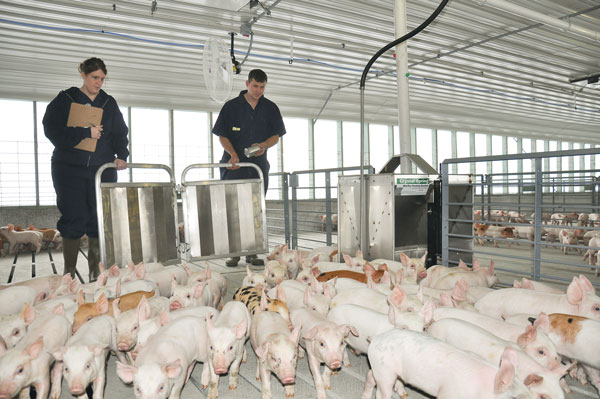June 20, 2016

The development of an efficient system to collect and report antimicrobial use in swine production continues to be a top priority for U.S. swine industry organizations.
The National Pork Producers Council, American Association of Swine Veterinarians and the National Pork Board continue to address issues related in antibiotic use and data reporting.
Recently Liz Wagstrom, chief veterinarian at the National Pork Producers Council, and Peter Davies, University of Minnesota professor in veterinary population medicine who was on sabbatical, traveled to several northern European countries to meet with government and animal health industry officials. This outreach was done to not only create a positive dialogue with these countries, but also to gather information that will be beneficial to the development of a system here in the United States.
According to Davies, “It is important to the development of a system for use here in the United States that we better understand the systems used in other countries. Assessing the metrics of each system will provide us with critical data necessary to create our own system.”
“The issue of reporting and recording antibiotic use is one of the most important detailed challenges producers and their veterinarians must address. We took the initiative to arrange these meetings with government and animal health officials and veterinarians as a means of outreach, to understand the system development and learn more about their ongoing research efforts,” Wagstrom says. “This information provides some of the critical data that will be needed to begin the creation of a system here in the United States.”
Wagstrom and Davies agree the goal is to create the best set of tools for use by the swine industry that will provide all the antimicrobial usage data being requested by officials.
According to Wagstrom, “One of the most important sets of criteria for the United States’ system is that it is both efficient and cost-effective for swine farms of all sizes.”
Davies says the issue of antimicrobial resistance, the continued availability of the antibiotics for treatment purposes in livestock production and how those issues relate to human health will continue for many years. “We must be proactive and create the system that will help us ensure what antibiotics we use today remain available.”
The pair did face one unexpected challenge while in Europe. They were scheduled to travel to Brussels, Belgium, on March 22 — the same day as the terrorist attacks in the capital city.
They agreed they were fortunate they had not yet departed for Brussels when the attack occurred. According to Davies, “At first we thought we would not have access to the officials from Belgium. It actually was not as difficult as one might imagine to get the meeting location changed, and we were able to meet with their industry officials later in the week.”
According to NPPC Chief Executive Officer Neil Dierks, their efforts to strengthen the relationships with other countries will be beneficial as the industry continues to fight challenges related to antibiotic use.
“It seems the discussion and challenges related to the use of antibiotics and animal health practices goes in cycles. Now more than ever it is important that the industry has a seat at the table to provide the facts about the present use of antibiotics in livestock production. Legislators and regulators will continue to challenge the use as long as activists and their constituents continue to raise the issue,” he says.
Wagstrom was appointed to a two-year term as the NPPC’s liaison to the Presidential Advisory Council on Combating Antibiotic-Resistant Bacteria. Dierks says, “Dr. Wagstrom’s appointment to that group is just one way that NPPC is engaged on this issue. Her representation of NPPC and the swine industry on that council is one of the most important opportunities the industry will have to communicate their position on the issue.”
Dierks points out that the issue of antimicrobial-use in production, antibiotic resistance and antibiotic residue in meat has been going on for decades. He believes one reason it is a reoccurring issue is the number of new consumers continues to grow, and those buyers mostly like do not know where their food comes from.
“It has always been difficult for consumers to understand why the use of animal health products is important in food production,” Dierks says. He also believes the marketing tactics of some food companies that promote their product while making claims that antibiotic residue can be found in meat is an even more difficult challenge.
One other challenge Dierks mentions is how difficult it can be to explain federal meat inspection guidelines and the physical practices that monitor for residues to protect the food supply.
“Much of this dialogue started when activists in Denmark began to challenge the use of antibiotics in water as a way to support piglet health. Even the documented declining health of early-weaned pigs in the nursery could not get the opponents to recognize the importance of the proper use of antibiotics,” Dierks says.
The direct relationship between the issues identified by the NPPC’s CEO has not been established. According to Dierks, “It is fairly safe to say these issues were part of the rationale used to press for the passage of new regulations.”
On Jan. 1, 2017, the U.S. Food and Drug Administration’s new regulations addressing on-farm antibiotic use in food-animal production will take effect. The agency’s effort is aimed at eliminating the use of medically important antibiotics for growth promotion purposes in food-animal production. Also included in the new regulations is bringing therapeutic use in feed and water to treat, prevent and control animal disease under additional veterinary oversight.
A definite timeline for creating the data collection and reporting systems has yet to be determined.
Philippi owns and manages Philippi Farms LLC, and is a photographer and writer in the Washington, D.C., area.
You May Also Like



